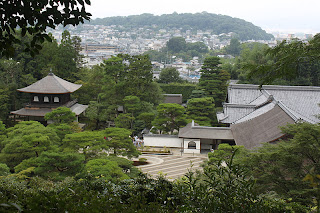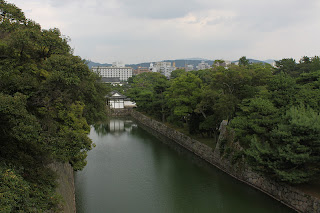Day two in Kyoto and we made sure we got an early start to avoid the heat as we were heading out to some of the most popular temples in Kyoto, the confusingly similarly named Ginkaku and Kinkaku temples. Ginkajku temple was built as a retreat for shogun Ashikaga Yoshimasa in 1482 to get away from the hubbub of the civil war, after his death it was converted into a Buddhist temple. Ginkaku has stunning gardens including white sand piled up to represent mount Fuji, raked gravel zen gardens and mossy woodlands. The woodlands provided perfect shade from the sun so they were very pleasant and relaxing to stroll around.
Raked rows of sand in Ginkaju temple grounds
The carefully smoothed pile of sand is supposed to represent mount Fuji, it was being maintained by a guy with a watering can and plastering board.
Here you can see the sand gardener at work.
Ponds and neatly trimmed bushes in the temple grounds
One of the many Shinto torii gates that can regularly be found in the grounds of Buddhist temples.
The raked sand looks almost like a beautifully rolled British lawn.
Obviously getting your coin to land on the rock in the middle of the pond is desirable.
Temple ponds.
Bamboo grove.
Looking back towards the city.
Beautiful mossy ground, showing where the rain runs off the trees.
A lovely peaceful pavilion beside a pond.
Stream running through the grounds
The HUGE gates in the entrance way to Nanzen-ji.
Like I said, those gates are pretty big!
The next gate isn't much smaller!
The ash from the incense seemed to have been shaped similarly to the sand at Ginkaju.
Aquaducts at the side of the temple.
The arches supporting the aqueduct.
A lovely little dragonfly posing for us.
I really enjoyed this raked gravel garden, it was quite relaxing to look at.
Covered walkway going through the gardens.
The bizarre spirals in the center of some spider's webs.
A little shinto shrine in the mountain valley.
Small little waterfall, just above the shinto shrine.
A little lizard, posing on a rock.
The rather grand moat of Nijo castle.
Entrance gate into the castle.
Gilded eves.
An elderly Japanese couple were going round posing for lots of photos in traditional kimono dress.
The moat was teeming with koi carp
Pretty impressive looking moat and walls.
The path leading around the top of the walls.
An overview of the castle buildings, within the walls it didn't look much like a castle as we'd recognise it, but was a land heavily affected by earthquakes there weren't many stone buildings in ancient Japan.
Looking out from the walls into the town.
Bridge over the moat.
Yet another dragonfly!
I'm not sure exactly where you could scribble apart from on the no scribbling sign!
The back of the castle.
Our final temple of the day was Kinkaku temple, which means golden temple, a name well deserved as it's top two floors are entirely coated in gold leaf. In 1950 the temple was burned to the ground by a monk who was obsessed with with the temple and felt the need the express his obsession by setting fire to it! So the current building dates from 1955 when it was rebuilt exactly following the original design but with extra gold leaf extending down to the first floor. Kinkaku is located at the northern edge of Kyoto and is one of the most popular sights in Kyoto. We were advised to arrive either at the beginning or the end of the day so we decided to come at the end, and the crowds weren't too bad.
A lovely butterfly which did it's best to avoid the camera.
A pretty cool tree in the grounds of kinkaku temple
The golden temple used to only have the top floor covered with gold but when rebuilt gold leaf was added to the first floor, I guess we are lucky it was burnt down, looks much more impressive!
Temple with reflection
There was a heavy rain shower just after we arrived, luckily it didn't last too long.
It's not just Korea that has crazy t-shirts!
Japanese beef cuts, I guess.
A rather bizzarely named shop
A very grumpy looking at which looked so cool we had to buy the one on the left.
Sophie with some crazy posters!
We found some pretty awesome Belgian beer in a bar near our hostel.























































No comments:
Post a Comment